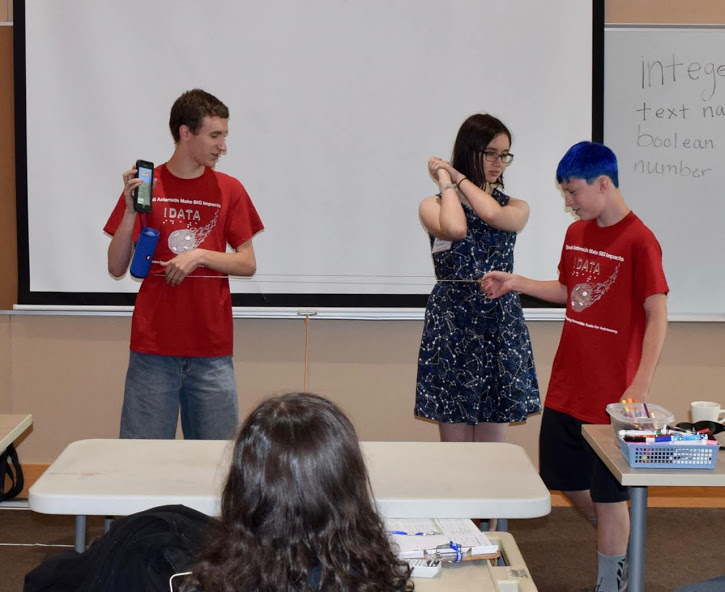Part 1F: Orbital Elements of Asteroids
ACTIVITY
What measurements do you think are needed to determine where an asteroid is in space, and hence, where it will be in the future?
Use your journal to write down at least four ideas.
******************************
Astronomers have determined that six elements, or measurements, are needed.
- Three elements are needed to determine the orbit’s shape and inclination to the plane of the solar system.
- The other three are used to determine the position at any given time in the orbit.
A hands-on activity for the six orbital elements is coming up in a different Part.
Only two of the elements will be focused on in this Module.
Element #1: The semi-major axis.
- Symbol: a
- Units: au (astronomical units = the average distance between the earth and sun – more on this later)
Element #2: Eccentricity
- Symbol: e
- Units: NONE. It is a ratio which describes how “squashed” a circle is, and ratios have no units since they cancel out.
The shape of an asteroid’s orbit is an ellipse:
ELLIPSES
A bit of history:
Johannes Kepler, in 1605, found the solution to data collected by Tycho Brahe for the position of Mars in the sky. It took him 40 failed attempts before arriving at the idea of an ellipse. He thought an ellipse was too simple, and, why was it not tried before? Now it is known that objects gravitationally bound to a star (our sun, for example) orbit that star in elliptical orbits. A circle is a special case of an ellipse.
The shape of an asteroid’s orbit is also an ellipse. Let’s explore this interesting shape. Kate from GLAS education will explain the properties with a demonstration using a piece of cardboard with a white piece of paper on top of it, two push pins, a looped piece of yarn to place around the pins, and a pen that pulls the yarn tight in this 7:30 video.
As you are watching/listening to the video, keep in mind the following vocabulary words.
a.) ellipse
b.) major axis
c.) semi-major axis
d.) focal points
e.) eccentricity
A people demo illustrating the same concepts follows further down the page.
People Demo
This activity will help reinforce the vocabulary words:

1.) Two people represent the focal points and stand inside a long string tied in a loop.
- For an object orbiting in a solar system, the sun (or any star) is at one focal point, and nothing is at the other.
- The person representing the star should hold their phone while it is playing a tone of some kind. The orbiting object should move faster as it gets closer to the star (or tone). Discuss with the group why this should be part of the demonstration.
2.) A ring or carabiner, connected to the loop of string, is held by a third person.
3.) This person represents an orbiting object.
- The person pulls the ring to put tension on the loop, walking around the other two people.
The loop of string represents the idea that the sum of the distances from the focal points to any point on an ellipse is a constant.
- Discuss this with the group.
Use your Journal to answer these questions:
1. Measure the distance in senisible units between the two foci (the two people inside the loop).
- Record this as the variable ‘d’ (type d= ).
2. Describe the major axis in this people demo, then measure this distance in the same units as #1.
- Record this as variable ‘L’ (type L= ) for this distance.
3. Describe the semi-major axis and measure this distance, also in the same units as #1.
- Record this as ‘a’ (a= ) .
4. Calculate the eccentricity e of the people demo using your values for d and L in the equation: ‘d’ divided by ‘L’. Record .
5. How could you change the position of the people in the demo to get a larger e?
Use the following list of eccentricities of some objects in the solar system to answer questions 6-10.
Mercury 0.206
Venus 0.007
Earth 0.017
Mars 0.09
Jupiter 0.048
Saturn 0.056
Uranus 0.047
Neptune 0.009
Pluto 0.250
Journal Questions (use any resource)
6. What is the eccentricity of a circle?
7. Which object in the solar system has a path closest in shape to a circle?
8. Which is the most eccentric?
9. What is your guess about the eccentricity (shape) of an asteroid’s orbit?
10. In conclusion, does a smaller eccentricity mean the shape is more elliptical or more circular?
